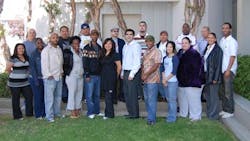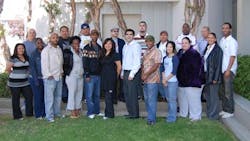From Underperformance to Overachieving: Culture Change at Bayer Berkeley
Editor’s Note: This article is part of an ongoing series featuring manufacturing teams that are excelling and moving the industry forward. If you have a team that deserves notice, please email us at [email protected].
Over the course of more than five years, Bayer HealthCare has undertaken a formal operational excellence initiative within its biotechnology operations. Deploying Lean Six Sigma has created significant operational efficiencies and cost savings. In fact, Bayer employees have generated millions in savings in the past few years by implementing changes to their work processes as a result of Lean Six Sigma projects. These strategies are often applied on a project-by-project basis as organizations continue to focus on operational excellence. This case study describes how one team at Bayer's Berkeley biotechnology manufacturing supply center has piloted an approach that uses a foundation of cultural change to bolster operational excellence initiatives—transforming their operating model for continuous improvement.
The Before Picture: A Glaring Need for Improvement
B55 is one of three production facilities at Bayer HealthCare’s biotechnology manufacturing campus in Berkeley, Calif. The facility was significantly underperforming compared to other production facilities on the same site, with lower production volumes compared to other production facilities on campus, higher rates of incident reports and batch record errors, and a higher number of OSHA reportable injuries.
Whether it was a cause or effect of the underperformance, morale was low. Operators in B55 describe a “before” picture of an organization with significant employee relations issues. The organizational structure was very hierarchical. Information was available to staff on the production floor only on a “need to know” basis, and decisions or changes imposed by management created an “us vs them” culture, leading the staff on the floor to behave in self-protection vs. business-protection mode.
Operators were rarely challenged or challenged themselves. They did tasks they preferred or felt confident doing. As a result, there was moderate technical proficiency in the entire fermentation and media process in B55. In addition, employees tended to work in silos and this limited their shop-floor interactions. There was an environment of individuals working side-by-side, but not together—that is, doing independent work on a continuous work stream. This poor communication extended to within extended to interactions with other functions, such as quality, warehouse, and procurement.
There were other problematic issues as well—the frequent wasting of materials, operating in a “fire fighting” mode, viewing Quality Assurance as a policing function—all of which were symptomatic of larger operational issues.
The Steps Toward Success
A change in production management at B55 provided Bayer, and the B55 team, the opportunity to alter its course. Saulye Sherrell had previously worked for Bayer in operational excellence and after a brief hiatus returned to the company in the new role of B55 production manager. Her first step was to take stock of the situation. Sherrell met with every supervisor and operator as well as the people who provided support to the facility, from manufacturing sciences to quality and from procurement to warehouse. She saw an opportunity to create a new cultural foundation to support operational excellence on an ongoing (vs. a project-by-project) basis.
The first step was to change the role of the supervisor from director to facilitator. The continuing change has had a profound impact on morale and on technical proficiency.
Today, supervisors in B55 no longer control key steps in the manufacturing process such as ordering reagents or other supplies. Instead, they focus on “Servant Leadership,” a philosophy and practice defined by Robert Greenleaf and supported by management writers from Peter Senge to Stephen Covey. B55 supervisors work to coach and support the operators who are working in self-directed teams.
In addition, supervisors are charged with supporting the professional development of the operators. In fact, every employee in B55 has a Development Action Plan that traces his or her technical certifications, business process knowledge, and alignment with Bayer’s cultural values. Not only do supervisors meet regularly with every operator, Sherrell meets with each on a quarterly basis to review development goals, training needs and career aspirations for each employee. These “skip level” meetings are a great source of ideas and help build operator confidence as subject matter experts.
The team worked with Manufacturing Sciences to develop the MS Academy to deliver key training programs that operators needed to achieve greater technical proficiency and to better understand underlying scientific premises in the manufacturing process. Safety initiatives have also paid dividends, reducing OSHA recordable accidents over a two year period to zero. The outcome of all of these changes is a highly motivated work force which has increased its technical proficiency, from operators who were certified on 69% of process steps to those who are certified on average as proficient in 93% of the process steps.
Out With Elephants, In With NASCAR
Lurking in every organization is at least one elephant—the problem that some can see, but no one wants to acknowledge. Poor performance was our elephant, and Sherrell had to begin to make operators aware of significant performance issues of the team while also tackling low morale. She set the stage for B55’s first-ever Kaizen event by making sure everyone understood the performance issues to be addressed: the 25% lower fermenter productivity, higher error rates and recorded accidents than other teams; misguided employee attitudes toward compliance; poor working relationships with other functions, and poor relations between supervisors and employees.
Through the Kaizen event the B55 team mapped its process and identified several potential projects to improve their productivity. They agreed that better production results would begin to change perceptions about their performance among the site’s leadership.
The result of the Kaizen was a “re-mapping” of roles and responsibilities which led to what the team calls “Standard Work.” Through Standard Work, the B55 team has changed how both the physical operations and business processes are completed by standardizing best practices. Through Standard Work employees have:
- Better understanding and ownership of the production process from beginning to end
- Clearly defined and consistent—always the same—responsibilities for each operator and each shift team with standard tasks to perform throughout the work day.
“When you think of manufacturing you think of doing the same thing again and again,” says Sherrell. “People may have been doing the same thing every time they came to work but it didn’t necessarily advance the process efficiently or link to the work of others. In essence, we truly made what should be routine, always routine.”
As one operator said, “It’s like NASCAR. When you have a pit crew during the race, every mechanic in that crew has a specific job to do and everyone knows how the different tasks will get done, in the right order, to get the car back out into the race.”
Today, each shift is responsible for specific parts of the production process and each operator is responsible for clearly defined tasks that ensure the completion of a shift’s production process. Individuals are responsible for their assigned tasks and are knowledgeable about the shift’s shared part of the process and how it contributes to the overall production of each batch. This structured approach takes the guesswork out of any day’s work and reduces variability in the output of equipment and the ultimate output from the facility.
Through Standard Work, operators track their standard work steps and the time used to complete tasks. This time tracking has allowed the team to carve out “available time” to work on projects and problem solving.
Initiating Operational Excellence
Once they standardized their work, the B55 team identified key projects to improve their productivity. Some examples below demonstrate changes to actual production steps while others demonstrate changes in general operating principles:
- Quality on the floor. Quality staff and B55 team members identified that increasing the dialogue and reducing the time delay between submission of data and feedback from the Quality organization could, in fact, reduce incident reports and batch record errors. Today, Quality staff regularly work with operators on the production floor to provide direct feedback and help identify solutions.
- Aeration basket/harvest flow meter project. A cross-functional team of operators and manufacturing scientists conducted an analysis of flow and pressure associated with the aeration basket. The team evaluated the impact of tube length, tension and joints. Minor modifications resulted in significantly increased fermenter output.
- Shift from “substores” to point-of-use Kanban. Historically, B55 operated as many production facilities do—with supervisors ordering materials and warehouse personnel delivering these materials to “substores” within the manufacturing facility. Operators would take needed materials, but there could often be a “stock out” for the next technician needing the same supplies. Today, warehouse personnel work within B55 based on a standing inventory of materials that should be available in supply cabinets throughout the facility. They check supplies, order, and place new inventory so that the facility is never without needed materials to complete production steps. This has also reduced the facilities’ SAP transactions from 50 to 60 per week to about 10—minimizing demands on procurement and accounting staff as well.
- Shift from stainless steel to disposables. The media group working in B55 decided to transfer material originally stored in traditional bullet tanks to disposable bags in their cold room storage area. The shift from tanks to disposables created significant savings by reducing hours required for CIPs and calibrations. The use of disposables also reduced hazards associated with the operation and maintenance of these large tanks and the movement of 750 liter drums. The team is now planning to reduce use of 250 liter drums and take advantage of bin storage systems.
Celebrating their successes along the way has been key to the new team culture of B55. The team showcased its improvements to the more than 1,400 employees in Berkeley in November 2008. Using a theme of innovation meets production, B55 hosted a poster session open house in which operators developed and presented posters for more than 20 projects that were successfully implemented.
B55 Today: A Process Centric Organization
Today, the team at B55 is no longer in functional silos. There are now defined core processes with individuals in different functional roles working together to implement the process. Each process then has an owner accountable for the process design, deployment, performance targets, and assessments. Through Standard Work team members know their specific work steps in the process, the decision points and decision makers, and established a common terminology about each step of the process.
Standardized Checks: Process owners, in collaboration with key functional groups such as Quality and Engineering, conduct monthly consolidated inspections. Grouping the various plant assessments together provides a streamlined approach that reduces the time spent by B55 in audits while also generating the benefit of cross-functional perspectives on all audits and inspections. Today, supervisors who “own” processes work with other departments on a monthly inspection for 5S, Safety, Compliance, and GMP, capturing critical action items and ensuring follow up.
Problem Solving Culture Focuses on Discovering the Root Cause: With a focus on continuous improvement, the B55 team identifies problems and projects through supervisors, skip level meetings and development action plan discussions. Leveraging the eight operators who have specific areas of expertise the team deploys a “5 Why” question-asking method to explore the cause and effect elements of a particular problem and ultimately identify the root cause. Once the root cause is identified a project is added to the Project Portfolio. As of this writing, the B55 team had identified 95 projects and prioritized these; 31 were actively being worked on by project teams.
Results
B55’s productivity statistics demonstrate sustainable results, including:
- A greater than 50% increase in fermenter production
- A greater than 50% reduction in incident reports
- A 90% reduction in batch production record error rate and a rate that is 1/3 below site average
- A 100% reduction in OSHA reportable injuries
- A 69% to 93% increase in technical proficiency of operators
And, all of the above was achieved while streamlining work and reducing the number of individuals needed to perform the work by more than 40%.
The team from B55 is collaborating and partnering as their colleagues move from project-specific operational excellence initiatives toward a culture that will continue to support continuous improvement.





